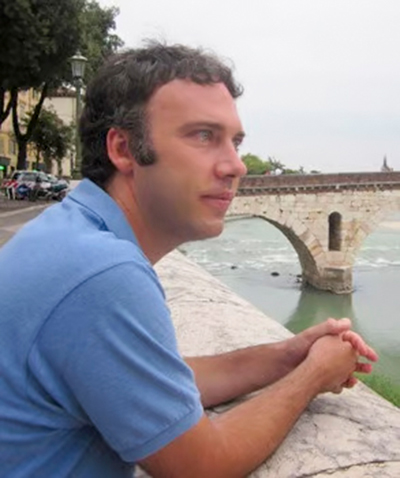Aureliano Cattaneo

Born: January 1, 1974, Lodi, Italy
"Aureliano Cattaneo is a composer full of obstinacy, versatility and imagination of sound. He has proved his talent with works in various genres, ranging from string quartets to the great orchestral form to opera, and is one of the most promising representatives of his generation." (Jury of Musikpreis Salzburg 2013)
"The music is full of whispered secrets and dizzying spirals, gossamer effects and sybaritic surprises. Cattaneo has an assured sense of architecture, a feel for dramatic pace, fine aesthetic sensibilities and plenty to say." (Financial Times – Shirley Apthorp)
Aureliano Cattaneo was born in Italy in 1974. He studied piano and composition with Vincenzo Balzani, Carlo Landini, Pippo Molino and Sonia Bo in Piacenza and Milan. He attended masterclasses with Gérard Grisey and Mauricio Sotelo.
Winner of prizes of composition, in 2003 he won the "Comité de Lecture de l'IRCAM/Ensemble Intercontemporain" and in 2005 he was selected as "Stipendiat" by the Akademie der Künste of Berlin. In 2007 He was composer in residence of Ensemble 2e2m, Paris.
He has been awarded with the Förderpreis of the Musikpreis Salzburg 2013. In 2016 the Italian association of music critics awarded him with the prestigious “Premio Abbiati.”
His works are performed in some of the most important festivals and venues: Münchener Biennale, Donaueschinger Musiktage, Wittener Tage für neue Kammermusik, Wien Modern, Festival Musica Strasbourg, Biennale di Venezia, Salzburg Biennale, MärzMusik Berlin, Musica Viva München, Warsaw Autumn, Milano Musica, Festival Presences and Festival Manifeste Paris, Wien - Konzerthaus, Berlin – Konzerthaus and Philharmonie, Zürich – Tonhalle, Paris – Philharmonie and Centre Pompidou, London – Royal Concert Hall and Wigmore Hall, Hamburg – Elbphilharmonie, Köln – Philharmonie, München - Gasteig, Madrid - Auditorio Nacional, Barcelona – Auditori, Essener Philharmonie.
His music is performed by such soloists as Patricia Kopatchinskaja, Nicolas Crosse, Irvine Arditti, Sophie Schafleitner, Francesco D’Orazio, Krassimir Sterev, Otto Katzameier, Donatienne Michel-Dansac, Daniel Gloger, Sebastien Vichard and played by leading ensembles and orchestras as SWR Sinfonie Orchester, WDR Sinfonie Orchester, ORF RSO Wien, Philharmonia Orchestra London, Orchestre National de Lille, Essener Philharmoniker, NOSPR Katowice National Radio Orchestra, Konzerthaus Orchester Berlin, Orchestra Sinfonica della RAI, Ensemble Intercontemporain, Klangforum Wien, Collegium Novum Zürich, ensemble musikFabrik, Ensemble Contrechamps, Quatuor Diotima, Cuarteto Casals, Trio Accanto, Mdi ensemble, Öenm Salzburg, Schola Heidelberg, Les Percussions de Strasbourg, conducted by Emilio Pomarico, Matthias Pintscher, Sylvain Cambreling, Marin Alsop, Jonathan Stockhammer, Alexander Bloch, Francois-Xavier Roth, Stefan Asbury, Roland Klutting, Susanna Mälkki, Bas Wiegers, Giovanni Antonini, Beat Furrer, Michael Wendeberg, Lothar Zagrosek, Lucas Vis, Johannes Kalitzke, Enno Poppe, Lars Mlekush, Walter Nussbaum, Lin Liao.
Since 2010 he is professor at ESMUC (Escuela Superior de Musica de Catalunya) - Barcelona.
His works are published by SZ Sugar - Edizioni Suvini Zerboni, Milan. He lives in Madrid.
La nuit sombre per due voci e strumenti nello spazio ("The Dark Night for two voices and instruments in space")
- Composed: 2020
- Premiere: May 2, 2021, Matthias Pintscher conducting Ensemble intercontemporain with sopranos Peyee Chen and Rinnat Moriah. This performance is the U.S. Premiere of this work.
- CSO Notable Performances: This is the CSO’s first performance of this work.
- Instrumentation: 2 solo sopranos, flute, trombone, bamboo wind chimes, cowbells, crotales, güiros, metal plates, mokushos, rain sticks, semanterions, spring coils, thai gongs, timpani, tubophone, waterphone, wood blocks, harp, piano and strings
Questo nuovo lavoro é stato scritto per essere interpretato dall’ensemble intercontemporain insieme alla Gran Partita di Mozart alla Grande Salle de la Cité de la Musique. Su suggerimento di Matthias Pintscher infatti i cinque movimenti che lo compongo vanno eseguiti inframezzati ai movimenti della Gran Partita in modo preciso, con attacca e separazioni. Quest’idea di opera dentro a un opera viene poi moltiplicata dall’utilizzo di un testo composto da frammenti del romanzo di Jan Potocki, Manoscritto trovato a Saragozza, romanzo formato appunto da una labirintica struttura di storie dentro ad altre storie. L’organico del pezzo é poi opposto a quello della Gran Partita: gli strumenti sono divisi in quattro gruppi (soprano e flauto, soprano e trombone alto, trio d’archi e pianoforte e percussioni, trio d’archi e arpa e percussioni) disposti ai lati dell’ensemble di fiati, i due quintetti, e in alto nelle due balconate. Tutto il lavoro, di una durata di poco piú di venti minuti, é un labirintico gioco, di richiami, specchi, riflessi, opposizioni alla composizione mozartiana, senza mai citare la Gran Partita, ma in un dialogo costante con il lavoro mozartiano e quello di Potocki.
—Aureliano Cattaneo
This new work was written to be performed by the Ensemble intercontemporain together with Mozart's Gran Partita at the Grande Salle de la Cité de la Musique. At the suggestion of Matthias Pintscher, the five movements that comprise it are to be performed interspersed among the movements of the Gran Partita in a prescribed way, with some movements attacca, and some seperated. This idea of a "work encompassed within a work" is then augmented by means of a text composed of fragments from Jan Potocki's novel, Manoscritto trovato a Saragozza ("Manuscript Found in Zaragoza"), a novel formed precisely by a labyrinthine structure of stories within other stories.
The ensemble of the piece is, however, contrary to that of the Gran Partita: the instruments are divided into four groups (soprano and flute, soprano and alto trombone, string trio with piano and percussion, string trio with harp and percussion) arranged along the sides of the wind ensemble, the two quintets, and elevated in the two balconies. The entire work, lasting just over twenty minutes, is a labyrinthine interplay of references, reflections, and contrasts to Mozart's composition, without ever quoting the Gran Partita, but in constant dialogue with the Mozart work and that of Potocki.
—Aureliano Cattaneo (translated by Dr. Scot Buzza)